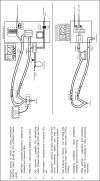COVID-19: dealing with ventilator shortage
- PMID: 36226709
- PMCID: PMC9612413
- DOI: 10.1097/MCC.0000000000001000
COVID-19: dealing with ventilator shortage
Abstract
Purpose of review: To describe different strategies adopted during coronavirus disease 2019 pandemic to cope with the shortage of mechanical ventilators.
Recent findings: Short-term interventions aimed to increase ventilator supply and decrease demand. They included: redistributing and centralizing patients, repurposing operating rooms into intensive care units (ICUs) and boosting ventilator production and using stocks and back-ups; support by the critical care outreach team to optimize treatment of patients in the ward and permit early discharge from the ICU, ethical allocation of mechanical ventilators to patients who could benefit more from intensive treatment and short term ICU trials for selected patients with uncertain prognosis, respectively. Long-term strategies included education and training of non-ICU physicians and nurses to the care of critically-ill patients and measures to decrease viral spread among the population and the progression from mild to severe disease.
Summary: The experience and evidence gained during the current pandemic is of paramount importance for physicians and law-makers to plan in advance an appropriate response to any future similar crisis. Intensive care unit, hospital, national and international policies can all be improved to build systems capable of treating an unexpectedly large number of patients, while keeping a high standard of safety.
Copyright © 2022 Wolters Kluwer Health, Inc. All rights reserved.
Conflict of interest statement
Figures


Similar articles
-
Challenges of Ventilator Procurement and Distribution in the ICU During the COVID-19 Pandemic: A Scoping Review.Crit Care Explor. 2025 Mar 28;7(4):e1248. doi: 10.1097/CCE.0000000000001248. eCollection 2025 Apr 1. Crit Care Explor. 2025. PMID: 40153548 Free PMC article.
-
Review of Anesthesia Versus Intensive Care Unit Ventilators and Ventilatory Strategies: COVID-19 Patient Management Implications.AANA J. 2021 Feb;89(1):62-69. AANA J. 2021. PMID: 33501910
-
Practical Considerations for Converting Operating Rooms and Post-anaesthesia Care Units into Intensive Care Units in the COVID-19 Pandemic - Experience from a Large Singapore Tertiary Hospital.Ann Acad Med Singap. 2020 Dec;49(12):1009-1012. doi: 10.47102/annals-acadmedsg.2020220. Ann Acad Med Singap. 2020. PMID: 33463659
-
[Hospital paramedic. An interprofessional blended learning concept to qualify paramedics and medical personnel for deployment in intensive care units and emergency departments during the COVID-19 pandemic].Anaesthesist. 2021 Jan;70(1):13-22. doi: 10.1007/s00101-020-00873-9. Epub 2020 Oct 9. Anaesthesist. 2021. PMID: 33034683 Free PMC article. German.
-
Mechanical-Ventilation Supply and Options for the COVID-19 Pandemic. Leveraging All Available Resources for a Limited Resource in a Crisis.Ann Am Thorac Soc. 2021 Mar;18(3):408-416. doi: 10.1513/AnnalsATS.202004-317CME. Ann Am Thorac Soc. 2021. PMID: 33202144 Free PMC article. Review.
Cited by
-
The Pandemic Allocation of Ventilators Model Penalizes Infants with Bronchopulmonary Dysplasia.Children (Basel). 2023 Aug 17;10(8):1404. doi: 10.3390/children10081404. Children (Basel). 2023. PMID: 37628402 Free PMC article.
-
An Internal Medicine Learning Collaborative Facilitating a Virtual Continuing Medical Education Program in Guyana and the Wider Caribbean During the COVID-19 Pandemic.Cureus. 2024 Mar 26;16(3):e56972. doi: 10.7759/cureus.56972. eCollection 2024 Mar. Cureus. 2024. PMID: 38665748 Free PMC article.
-
Challenges of Ventilator Procurement and Distribution in the ICU During the COVID-19 Pandemic: A Scoping Review.Crit Care Explor. 2025 Mar 28;7(4):e1248. doi: 10.1097/CCE.0000000000001248. eCollection 2025 Apr 1. Crit Care Explor. 2025. PMID: 40153548 Free PMC article.
-
Dialysis resource allocation in critical care: the impact of the COVID-19 pandemic and the promise of big data analytics.Front Nephrol. 2023 Oct 26;3:1266967. doi: 10.3389/fneph.2023.1266967. eCollection 2023. Front Nephrol. 2023. PMID: 37965069 Free PMC article. Review.
-
Risk Mitigation Measures Captured by a Tertiary Hospital's Disaster Simulation: An Observational Study.J Eval Clin Pract. 2025 Jun;31(4):e70113. doi: 10.1111/jep.70113. J Eval Clin Pract. 2025. PMID: 40323011 Free PMC article.
References
-
- Lassen H, A preliminary report on the 1952 epidemic of poliomyelitis in Copenhagen with special reference to the treatment of acute respiratory insufficiency. Fink M, Hayes M, Soni N, editors. The Lancet. London: Springer London; 1953. - PubMed
-
- Grasselli G, Pesenti A, Cecconi M. Critical care utilization for the COVID-19 outbreak in Lombardy, Italy. JAMA 2020; 323:1545–1546. - PubMed
-
- Berardi C, Antonini M, Genie MG, et al. . The COVID-19 pandemic in Italy: policy and technology impact on health and nonhealth outcomes. Health Policy Technol 2020; 9:454–487. - PMC - PubMed
-
A paper analyzing policies adopted by the Italian government to tackle virus spread during the first wave of the pandemic in the period March-May 2020 and their outcome. Interventions are analyzed from a health-care system (ICU saturation, mortality) and economic system point of view.
Publication types
MeSH terms
LinkOut - more resources
Full Text Sources
Medical
Research Materials

